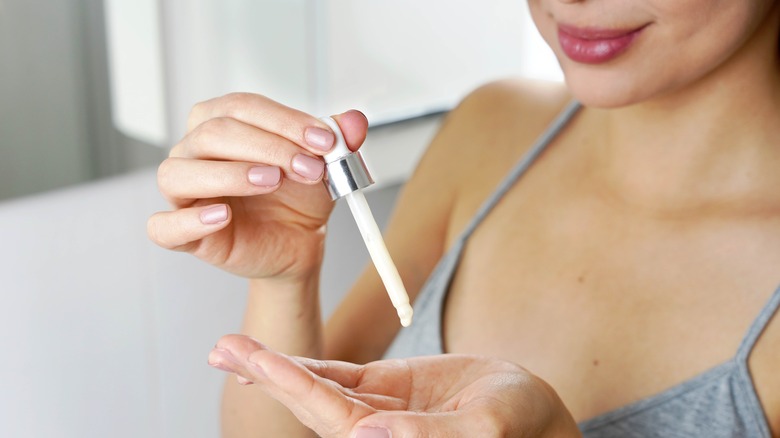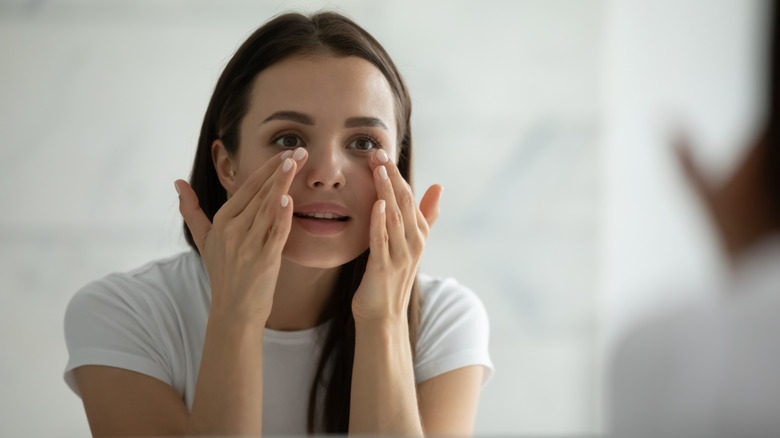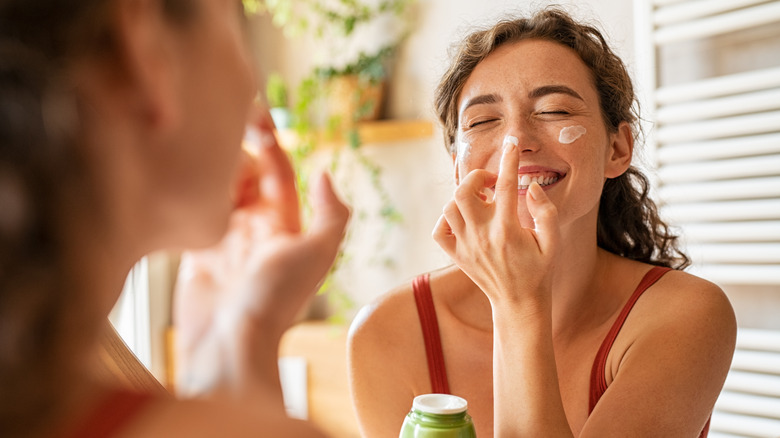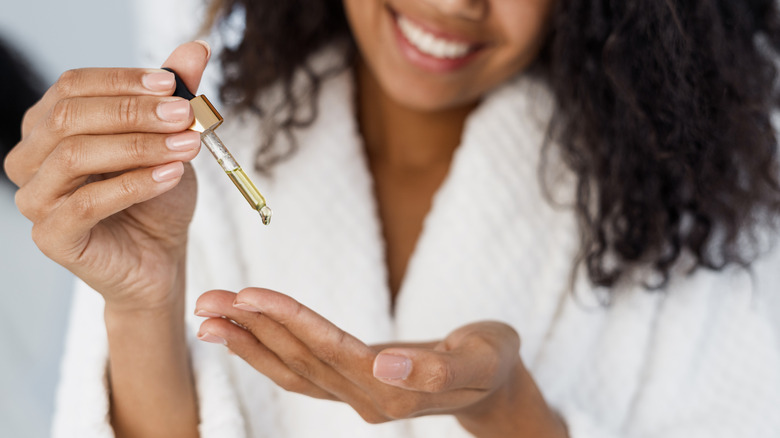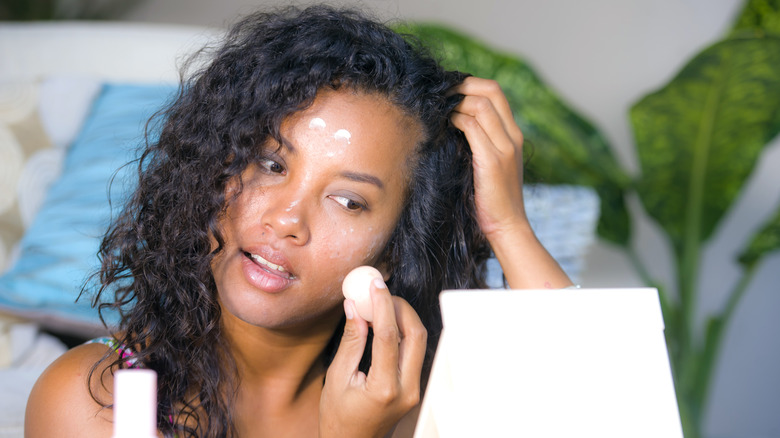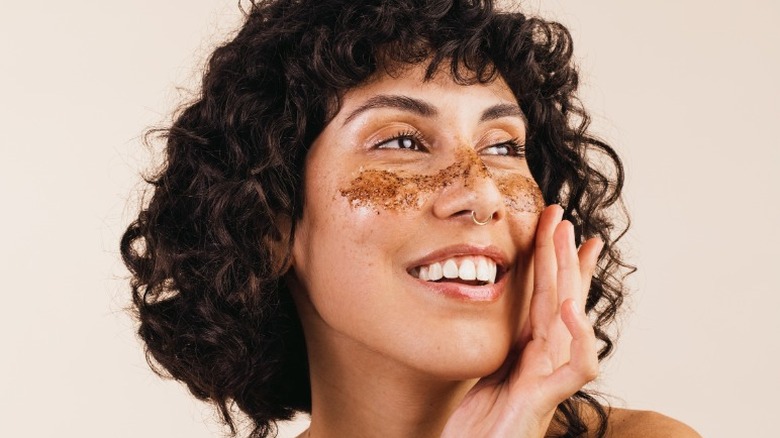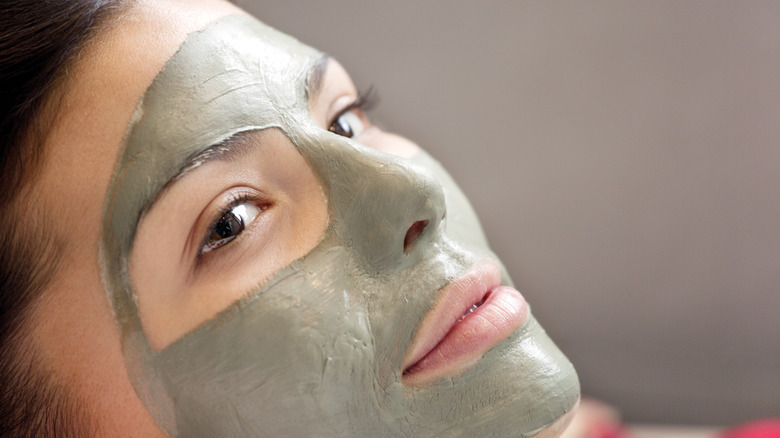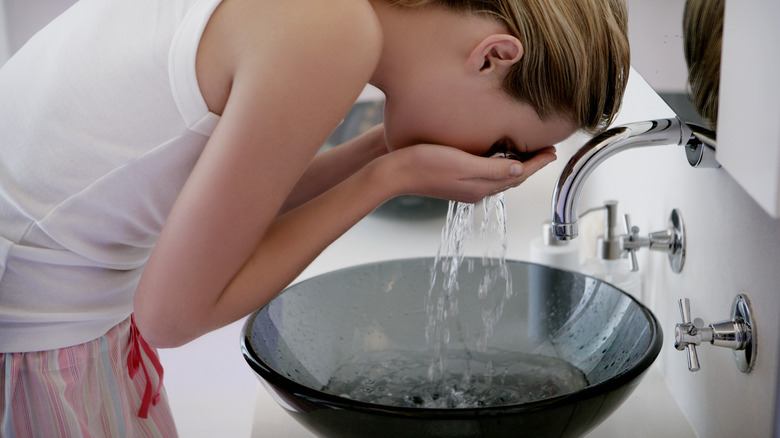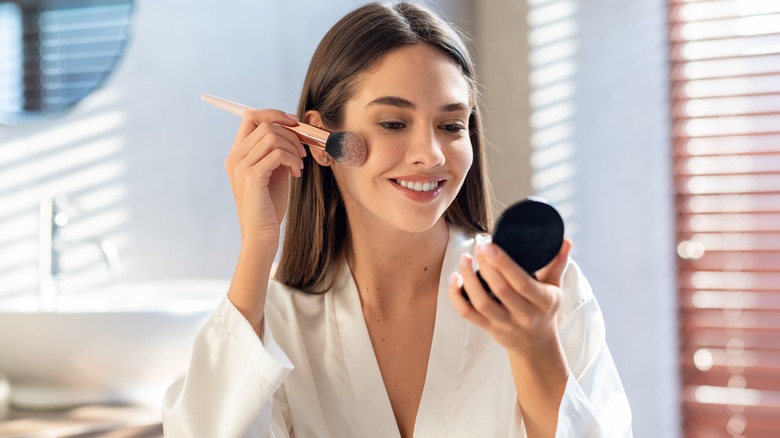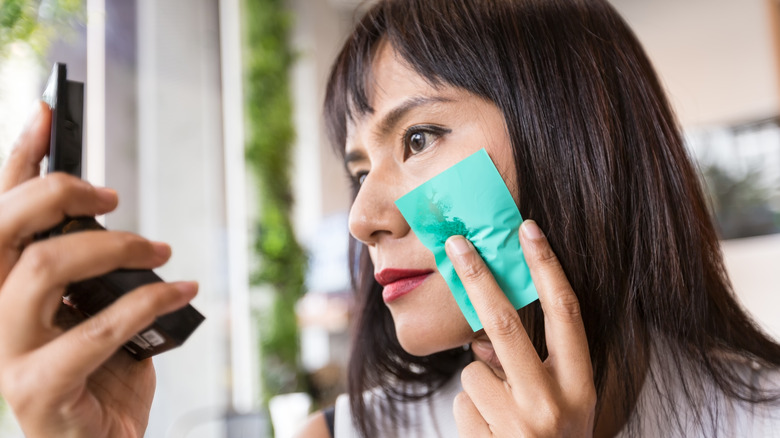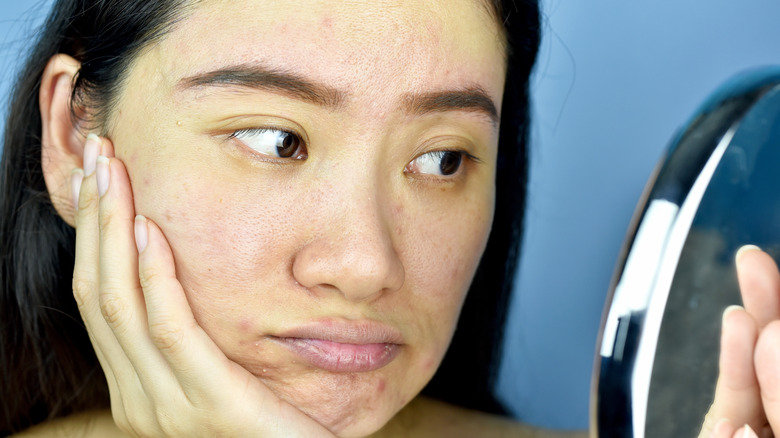If You Have An Oily T-Zone, Take These Steps To Keep Your Skin In Check
Having an oily T-zone generally means that no matter how matte you are when leaving your home, a couple of hours later, your forehead, nose, and chin will end up having a visible layer of oil on them. "We all have sebaceous (oil) glands on our skin that vary in the amount of oil (sebum) production they produce," board-certified dermatologist Chris Tomassian, M.D., tells Byrdie. "Oily skin is typically characterized by oily/shiny skin that typically presents all over the face. There is a subtype of oily skin, combination skin, which presents as oily skin on the T-zone (forehead, nose, eyebrows) but dry to balanced elsewhere."
Luckily, there are some things you can do or pay attention to in order to help your oil glands produce less sebum. These include changing your habits, adding specific skincare products to your routine, and simply removing the oil temporarily. Here's how to maintain an oil-free T-zone with the warmer months approaching.
Add niacinamide to your skincare routine
Chances are you've heard of niacinamide, the skincare ingredient that numerous beauty gurus swear by. One thing you may not have known is that the ingredient mainly known for its brightening and acne-reducing properties can also help with oiliness. "Niacinamide is essentially vitamin B3," medical and cosmetic doctor Ewoma Ukeleghe tells Refinery29. "Clinical studies have shown that niacinamide can improve excess sebum production (overly oily skin), the appearance of pores, fine lines, and keep the skin's barrier intact."
Since an oily T-zone tends to come hand in hand with big pores, niacinamide is also great for targeting pores and blackheads. "Not only can [niacinamide] help balance the skin, but it can also help with pore reduction," cosmetic chemist Ginger King tells Allure. Apart from the fact that niacinamide targets plenty of skin concerns, it is also suitable for sensitive skin, which means that the chances of it breaking you out or causing irritation are very low. Cosmetic chemist Shuting Hu tells Allure that niacinamide is "naturally occurring and essential to healthy skin cell functions," which makes it less irritating than other forms of vitamin B, which can "cause the skin to flush when applied topically."
Don't skip moisturizing your skin
If anyone ever tells you that you moisturizing oily skin will only make it more oily, know that they have no idea what they're talking about. "There's some belief that if you have oily skin, you don't need to or shouldn't moisturize," Sandra Lee, the founder of Dr. Pimple Popper, tells Healthline. "All skin types need moisturizer, but if you have oily skin, you should be more careful with what kind of moisturizer you're using."
In fact, not moisturizing oily skin often results in even more oil production. "The oil glands have the ability to sense that skin is drier and begin to overcompensate and produce more oils," board-certified cosmetic and medical dermatologist Blair Murphy-Rose, M.D., F.A.A.D., reveals to Byrdie. "Make sure to use a well-balanced light moisturizer and avoid products that break down the skin barrier, causing dryness and irritation."
No matter what skin type you have, applying moisturizer in the mornings and evenings is a must. And here's a little secret — you don't have to use the same moisturizer all over your face. If you have an oily T-zone, apply a lightweight mattifying moisturizer to only those areas. You can pick a heavier moisturizer for the rest of your face, especially if some parts tend to be on the drier side.
Opt for oil-free and lightweight products
For an oily T-zone, make sure to pick skincare products that won't clog your pores. "Generally, lightweight products are better for those with oily skin, as they are less likely to sit on the skin and trigger more oil production or clog pores," board-certified dermatologist Dr. Dendy Engelman tells The Zoe Report.
In fact, a lot of skincare products are marketed for oily skin, and those are generally the best option for anyone who gets shiny throughout the day. "Look for oil-free moisturizers that can help provide hydration without blocking the pores or leaving the skin feeling heavy," dermatologist Dr. Joshua Zeichner, M.D., F.A.A.D., reveals to The Zoe Report. Dermatologist Dr. Hadley King tells Skincare.com by L'Oréal that products with clay and charcoal, which absorb oil naturally, are the best options for oily skin.
Of course, everyone has different skin, so even though something is advertised as being perfect for oily skin — it might still break you out or damage your skin barrier. Therefore, it's always best to test a new skincare product on a tiny part of your skin and then wait 48 hours to see if any irritation will occur. This is sometimes so difficult to do — especially since you may get super excited about a new product that seems promising. Still, at the end of the day, it's much healthier for your skin to only experience irritation in a small area instead of all over your face.
Make salicylic acid a part of your routine
Aside from niacinamide, salicylic acid is another skincare ingredient for those with an oily T-zone. "Salicylic acid is a beta-hydroxy acid which is lipophilic, meaning it is attracted to and helps to break down excess oil," Andrea Pfeffer, founder of the skincare clinic Pfeffer Sal, tells Elle. "As an added bonus, it's anti-inflammatory and can penetrate pores to scoop out any debris, making it a great ingredient for targeting the congestion that often comes with oiliness."
Salicylic acid is probably best known as an ingredient for acne-prone skin, but since excess sebum is often also a cause of acne, it's not surprising that it can help fight both. Just like with any skincare product, you don't have to use it all over — especially if you tend to have more sensitive cheeks. Per CeraVe, you can use a salicylic acid product on a daily basis provided that the product is formulated to be gentle. However, we would recommend using a salicylic acid serum on your T-zone only twice or three times per week since the ingredient is a chemical exfoliant.
Wear a mattifying primer during the day
To ensure your T-zone doesn't get too oily throughout the day, consider applying a mattifying primer to it. "Mattifying primers help control oil throughout the day, but they're also amazing for minimizing the appearance of texture in the skin," professional makeup artist and content creator Jonet Williamson tells InStyle. Even if you don't plan on applying foundation over it, a mattifying primer can still help you keep your t-zone oil free for longer.
In fact, some mattifying primers also double as skincare as they contain ingredients like witch hazel and salicylic acid. If you haven't used a mattifying primer before, the best tip we can give you is not to go overboard — especially if you plan on using foundation. Use a dime-sized amount for your whole face, and if you're only applying it to your T-zone, use only half of that. Spread it out in a thin layer, and don't rub it in too much since that can cause it to end up looking cakey. If you're going over it with foundation, give the primer a couple of minutes to properly set in before you apply anything over it.
Exfoliate once or twice a week
Because an oily T-zone can lead to clogged pores and breakouts, exfoliating your skin to eliminate any buildup on it is crucial for this skin type. Chemical exfoliants are an excellent choice for any skin type, particularly for those who notice an increase in sebum production. "Use a chemical exfoliator to fight oil and acne from a deeper level in the skin," esthetician Rianna Loving tells Byrdie. "AHA and BHA acids (like salicylic, lactic, and glycolic) will be most effective. These will not only fight oil and remove pore-clogging dead skin cells but also improve skin's texture and repair acne scars."
A physical exfoliation every now and then can also benefit the skin, especially since oily skin tends to have dead flakes that can prevent other products from penetrating it properly. "When you have oily skin, your dead skin cells are more adherent and don't flake off as quickly, and this can contribute to breakouts," board-certified dermatologist Michelle Henry, M.D., reveals to Allure.
Apply a clay mask
Those with oily skin should incorporate a clay mask into their routine at least once a week. "Clay masks also absorb excess oils, as well as reduce surface shine and help reduce clogged pores," dermatologist Dr. Neal Schultz tells Bustle. "In terms of important ingredients, look for kaolin and/or bentonite as superior ingredients for these types of masks."
Most clay masks should sit on your skin until they completely dry out, which generally takes between 15 and 20 minutes, but it varies depending on how thick a layer you put on. Once again, feel free to use a clay mask only on your T-zone, especially if the rest of your face is on the dryer side. Clay masks are also perfect for anyone who wants to minimize the appearance of blackheads. "Bentonite and kaolin clay also draw out water and oil from your skin, which may temporarily make pores appear smaller," Dr. David Lortscher, the C.E.O. and Founder of Curology, adds (via Bustle).
Try eating more fruit and veggies
It's no secret that our diet impacts our overall health, skin included. One thing you may not have known is that what you eat can affect how much sebum your oil glands produce. "A high intake of alcohol, meats, as well as dairy has been shown to be associated with higher oil production," board-certified dermatologist Chris Tomassian, M.D., explains to Byrdie.
In particular, a diet that is high in meats is what impacts oil production the most. "Red meat, such as sausages, beef, lamb, and bacon, can be high in saturated fats, which can increase inflammation in the skin," dermatologist Patricia Boland tells Byrdie. "This excess inflammation can cause excess oil to be produced."
Sugar is another culprit of oiliness, so skipping dessert could potentially benefit your skin. "Research has shown foods high in sugar increase the production of IGF-1, a peptide hormone that stimulates growth, but also can cause an overproduction of sebum, aka excess oil," registered nutrition consultant Jenna Hope adds (via Byrdie). Those looking for ways to make their skin less oily should consider opting for a more veggie-friendly diet, and instead of grabbing deserts with processed sugars, pick up more fruits. It's easier said than done, but your skin will thank you.
Wash your face twice a day
Cleaning your face is essential to everyone's skincare routine, but whether you should wash once or twice a day depends on your skin type. Generally, those with dry skin should try to wash their face only at night, as "the natural oil our bodies produce is good for our skin — it provides a first defense barrier for the external factors of the day," aesthetician Athena Hewett tells Allure.
However, those with skin on the other end of the spectrum can benefit from washing their face twice per day, and not just because that will help remove the excess oil. "Twice-a-day cleansing removes the pollutants and irritants that our skin is exposed to 24/7 — even when we sleep," board-certified dermatologist Loretta Ciraldo reveals (via Allure). Per The Zoe Report, dermatologist Dr. Joshua Zeichner, M.D., F.A.A.D., advises that those with oily skin should "look for foaming cleansers, which are more effective at removing oil as compared to hydrating counterparts."
Check the ingredients of your makeup
If you wear makeup, it is crucial to ensure it's the right one for your skin type. Those with oily skin should stick to more lightweight foundations and formulas that won't cause breakouts. "Avoid makeup with silicones and mineral oil, which will clog your pores," celebrity dermatologist Paul Jarrod Frank, M.D., tells Byrdie. "Opt for an oil-free or water-based tinted moisturizer instead." Per Allure, makeup artist Mai Quynh advises avoiding "ingredients like jojoba or any other types of oils or emollients," which can make you appear shinier, cause your makeup to move around, and break you out.
Of course, if you only have an oily T-zone, the same foundation formula might not work for the oily parts of your face and the normal or dry ones. In that case, you can use two separate products to ensure your makeup doesn't have dry patches or move around. Another excellent option for an oily T-zone is a pressed or loose powder, which can give you coverage and mattify the skin at the same time.
Make blotting papers your best friend
The quickest and easiest way to eliminate excess oil in your T-zone is to use blotting papers. "They resemble tissue paper and are pressed into the skin, usually on the T-zone, to absorb oil and are then discarded," board-certified general and cosmetic dermatologist Rachel Maiman, MD, F.A.A.D., tells Byrdie. Most often, blotting papers are made from willow bark or abaca tree fiber, and "these agents lock onto oil and help lift it, as well as impurities, out of pores," Maiman adds.
Ensuring you always have a pack of blotting papers on the go will help you get rid of any unwanted shine throughout the day. And yes, you can absolutely use blotting papers over your makeup; just make sure you dab rather than drag the paper across your skin. When you press the paper onto your face, you will actually see just how much oil transfers onto it — which means you can tell when a single piece of paper has been used to its max.
Take care of your mental health
Stress always takes a toll on your body, and it is essential you take care of your mental health to prevent you from experiencing burnout. One thing you might be surprised to hear is that stress can also cause your skin to produce more oil, which is just another reason to work on lowering your cortisol levels. Dermatologist Dr. Joshua Zeichner, M.D., F.A.A.D., tells The Zoe Report that "our bodies' stress response leads to a spike in the production of stress hormones, and these have an impact on our skin by revving up activity of our sebaceous glands, leading to more sebum."
Of course, your oily skin shouldn't be the primary reason you should reduce the stress in your life — but it might just motivate you a tad bit more to actually do it. Our best advice is to ensure you regularly have time to relax and incorporate physical activity into your day. And learning how to say no is another crucial part of stress-free living; after all, when you have too much on your plate, your stress levels spike.
Stop using harsh products
Even though oily skin can generally handle chemical exfoliants and washing your face twice a day, that doesn't mean you should use harsh ingredients and experiment with your skincare a lot. "Avoid harsh astringents or alcohol-based solutions that can actually cause your sebaceous glands to over-compensate and produce even more sebum," board-certified cosmetic and medical dermatologist Blair Murphy-Rose, M.D., F.A.A.D., tells Byrdie. "Anything that dries the skin can cause this effect." Even though it might seem counterintuitive, those with an oily T-zone can absolutely use a cleansing oil to ensure they are not over-stripping their skin. "Cleansing oils don't disrupt our natural oil barriers, so you can't overwash with an oil cleanser," aesthetician Athena Hewett tells Allure.
When it comes to exfoliating, it's always important to listen to what your skin is telling you. Over-exfoliating with harsh products will cause you more harm than good. "Typically, those with oily skin may be more likely to over-exfoliate and use a combination of products to minimize oil that may be overly drying," board-certified dermatologist Dr. Carlos Charles tells The Zoe Report. "This can lead to sensitive, irritated, and dry skin, while not at all addressing the underlying issue of increased oil production, and should be avoided."

